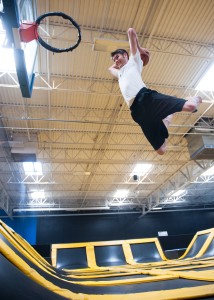SALT LAKE CITY — Utah legislators are looking at ways to regulate trampoline park safety and are using Provo, which has one of the only “jump gym” ordinances in Utah, as a model.

Rep. Norm Thurston, R-Provo, asked lawmakers May 17 for guidance in addressing trampoline park safety. There are currently no statewide standards regarding commercial trampoline gyms. During the 2017 Legislature, a House committee considered but never passed HB 300, a bill regulating trampoline park safety sponsored by Thurston and Provo Republican Sen. Curt Bramble.
Thurston suggested different ways of regulating gyms, from enacting city or county ordinances to simply doing nothing. However, he is concerned that if nothing is done, a future park could be opened with a safety problem “which damages the reputation of everybody,” he said.
Thurston cited Provo’s trampoline park ordinance as a model.
Provo City officials collaborated with medical experts to draft a city ordinance that would help prevent common injuries such as spinal cord damage and compound fractures. Thurston said every city across the state should consider regulations if it has a trampoline park.
Provo’s trampoline park ordinance requires operators to get a business license, educate participants about risks and safety practices and have participants sign liability waiver forms. In addition, operators must continually monitor trampoline courts and must carry at least $1 million of liability insurance.
Provo city inspectors review records while insurers or other qualified individuals without ties to the business conduct inspections of the trampoline court — at least yearly.
Rep. Craig Hall, R-West Valley City, a committee member, added that he “whole heartedly endorse(s) this conversation” as a parent whose child has been hurt at a trampoline park.
Rep. Douglas Sagers, R-Tooele, another committee member, questioned the need for regulations, comparing the nine-to-one ratio of injuries from home trampolines to trampoline parks. He related this statistic to the potential cost of addressing this issue, wondering if it would reap as much benefit.
Thurston said that the owners of home trampolines are responsible for the injuries of those who are allowed to use the trampolines. On the other hand, trampoline parks are different because they operate as a businesses open to the public.
“(Trampoline park owners) are inviting the public to come and use their equipment, which means that the public has a reasonable expectation that minimum safety standards exist,” Thurston said.
Rep. Val Potter, R-North Logan said data could be collected from Provo. Data could show injuries and cost of injuries before and after regulations were put into place.
Sagers said this data would be “really helpful.”




